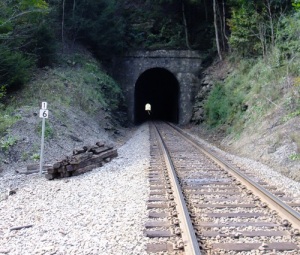Between Burdine and Elkhorn City KY beside Highway 197 stand these monuments to a rail line long gone. They look freakishly like a pop art version of Stonehenge. The one on the left is not leaning precariously, that’s lens distortion. These are located at approximately 37.229696, -82.524684. The reason they line up like this is that the railroad crossed this highway at a sharp angle, but the piers had to allow for the roadway. This bridge was intact in 1996, but gone in 2000. It appears to have originally connected a mine area (later a strip mine) some miles to the north with an interchange near Burdine. The earliest image Google Earth has of this area was taken in 1995 (enable “historical imagery”). You can clearly see where this line went.
Month: October 2011
#10 Red Ridge Tunnel
16 miles south of Elkhorn City, 1,359′ from portal to portal. The refurb date has eroded away on both sides. We’re just south of Goff Tunnel, very near what turned out to be the now-lost town of Steinman. We had accessed the tunnel down a semi-private one-lane road, which went past a couple of houses. We pulled up to the railroad (CSX has access rights to the property, as we found out), got out and took some pix. On our way out, we saw a stern looking man watching us from the side of the road, near one of the houses. Judging this to be the property owner, we slowly stopped and Lee jumped out of the car with the topo map and began to explain what we were doing and pointing to the tunnel on the map. The man, surprisingly, looked relieved. “I thought y’all were hunting ginseng!”, he said. After that, things went swimmingly, with the man telling Lee that his mom (the man’s, not Lee’s), who lived right next door, was a amateur historian of the area. They proceeded on to the other house (I stayed in the car…this was Lee’s show and I wasn’t hearing any tunnel chatter) and had a ten-minute or so talk with the woman. That’s how we came to know about Steinman and the cable car system that brought coal from across the valley to be dumped into a tipple there at the town and later dumped into coal trains heading south to feed the mighty industries of the blah blah blah. On to Sykes Mill Tunnel.

Not a tunnel, but…
Well, there we were, hiking along a little-used line that runs from Appalachia to the strip mines above St. Charles. We’d parked at the location where a small town called Delvale once stood and started walking west to check out the four trestles we’d spotted along a two-mile or so stretch. These trestles are often dated with plates from the manufacturer, American Bridge Company. We were probably a mile or so from Delvale when Lee spotted this: two medium-size grist stones embedded into a concrete pedestal. There are no markings we could see on the pedestal. Lee’s foot is resting on the remains of a foundation, perhaps of the mill, but this location is, say, 50′ above the Powell river and there are no streams around…and no roads, either. And why were they mounted up like this? Enquiring minds want to know. In case you’re interested (yeah, right), this location is 36 48′ 40.2″ N 82 57′ 32.3″ W, more or less. (later: Lee, who has the topo for this area, happened to mention that “Mill Creek” runs right down by this location. Well, that makes sense.)
Up in Kentucky
This tunnel, on a CSX line from a large strip mine in Myra KY, is in Virgie KY. I backed off to show the chimney above the tunnel. The tunnel itself has been sprayed with quick-setting concrete and has rock bolt reinforcements all along its length. The line goes from here to the big rail yard at Shelbiana. Once, the line went south of Myra, but it’s just empty railbed now. There were plenty of short trestles on this line…every blessed one of them made by American Bridge Company in 1911. The company is still in business…and so are the trestles on the active line. The trestles on the dead line that don’t go over the 2-lane highway have been removed, but the locals say that, even though the railroad has to carry insurance on the extant trestles, they’re just too expensive to move, since they’d have to somehow reroute the traffic when the crane comes in to haul out these hunks of tonnage.
Big Bull tunnel
There are three tunnels on the Norfolk and Southern line between St. Paul northwestward to Coeburn. They’re all old tunnels and faced and dated at time of construction. This is Big Bull tunnel, centered at 36.917577, -82.359635. It’s about 1,500′ long. Date’s 1904. I particularly like how these tunnels were finished up. Nice stonework.
A Sidebar on rails
Non-continuous steel rails were often dated when forged or extruded or whatever the hell they were. The date isn’t stamped into the rail, but is a bas relief, like this one on a siding rail between the old Holston Glass and Holston Distributing buildings in Kingsport. The date is 1920. Trust me.

In Dante yard, in the old area around the turntable, the track was more recent. 1927, t’be exact.

This is near to the earliest we’ve seen. The Kingsport track, assuming it was laid down within a year or so after it was forged/extruded/whatever, dates to near the time that the city was re-chartered in 1917. I stand there and wonder what the area looked like then. Pretty thin on the ground, I’ll bet.
#9 Goff Tunnel
Wrecked locomotives

 This is the front of 439.
This is the front of 439. This is the engineer’s control area…not badly damaged at all.
This is the engineer’s control area…not badly damaged at all.
But whatever happened to these two engines must have been scary to be in.


